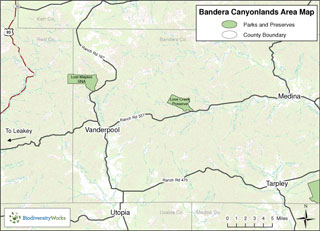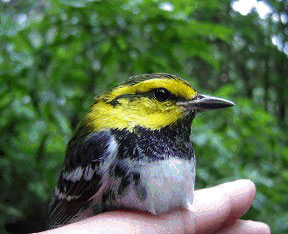Bandera Canyonlands Alliance
Biodiversity Works previously worked with members of the Bandera Canyonlands Alliance (BCA), a non-profit, wildlife management association formed by private landowners in 2007 to manage, protect and preserve the ecological systems that support the biodiversity, water resources, natural beauty and rural way of life in the Bandera Canyonlands. Activities of BCA support the following goals:
- Conservation and enhancement of native plants and wildlife with a focus on maximizing native biodiversity.
- Protection and preservation of the abundance and quality of water resources.
- Promotion of “best practices” for Ashe juniper management.
- Enhancement and maintenance of landscape integrity.
- Education of members and the public on the benefits of good land stewardship and conservation in the Bandera Canyonlands.
The Bandera Canyonlands region, which includes western Bandera and eastern Real counties, is home to three federally-endangered species: the Golden-cheeked Warbler, the Black-capped Vireo, and Tobusch fishhook cactus. Currently, there are 29 landowner-members of the BCA, comprising over 16,000 acres of private land. Nearby protected lands in this region include Lost Maples State Natural Area (Texas Parks & Wildlife Department) and Love Creek Preserve (The Nature Conservancy).
Most BCA members manage their land for the benefit of wildlife. Primary activities include brush management, prescribed fire, feral hog control, white-tailed deer management, and brown-headed cowbird control. Since September 2008, ten BCA members have been participating in a project funded by Texas Parks and Wildlife Department’s Landowner Incentive Program; land management activities under this project include brush thinning to enhance Golden-cheeked Warbler habitat and prescribed fire to restore and enhance Black-capped Vireo habitat. Several BCA members manage specifically for the benefit of songbirds, with a focus on the two endangered birds mentioned above. In the past, these landowners have allowed scientists from Environmental Defense Fund and its consultants to conduct yearly breeding bird surveys to monitor the diversity and abundance of resident and migratory species.
Biodiversity Works provided guidance and assistance to members of the BCA on various land management activities, including brush thinning projects, prescribed fire planning and implementation, and cowbird trap placement and operation. Additionally, Biodiversity Works conducted breeding bird surveys on participating properties.


